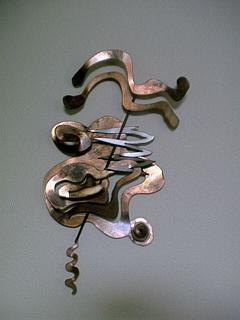|
Cold-weldingcould solve your problem?SOLUTIONS with Effective, Powerful Advice
Cold-welding, (what a surprise!), is a process performed at room temperature. It uses mechanical force or pressure to bring two metallic surfaces in intimate contact. Then interatomic forces are developed to complete the weld, while considerable plastic deformation is taking place. The need for metal distortion and flow to perform Cold welding, excludes that brittle materials could be joined by this process.
However many combinations of ductile dissimilar metals can be joined by Cold welding, even those that could never be joined by fusion welding. Note: A clarification may be in order. Cold refers to the surfaces undergoing welding. Also Explosion Welding (see further down) is a cold process. The explosion (not cold at all) generates the impact producing welding between the materials. No melting occurs. There is no fusion of either metal, so that welding performed cold is included in the class of solid state welding processes. To be successful cold welding must provide for the disruption of surface oxides if they are present. Only by reducing them to separate tiny particles, they do not interfere with the process. Shattering of the oxides during material flow is due to their brittle nature. Microscopic observations confirm that the interface becomes a phase boundary and that oxides are not interfering with the soundness of the bond. Many variants of the basic Cold-welding process are known to have been implemented. Deformations can be made in lap or butt configuration and can involve press forming, drawing and extrusion.
Roll Welding is a process variant, dealt with separately. (Click on the link to see the page). Lap Cold welding could be explained as a variant of resistance spot welding, where two overlapping sheets are joined at separate spots. Except that no current and no heating are involved, and there is no fusion. Instead considerable deformation is generated in the transversal direction to that of the applied pressure.
If you did not yet find what you need, why not typing your question in the following Search Box?
Cleaning should be performed just before cold welding, especially in easily oxidized materials like aluminum, because it is a critical requirement. Various thicknesses can be joined, from 0.1 to 15 mm, provided sufficient striking force is available. Cold-welding is performed by clamping the sheets to be joined between two dies or indenters and by striking a powerful blow that deforms a definite region of the material. The meeting protrusions that appear in the interface result welded together by the pressure. Different shapes of dies can generate a round spot or a circular ring or a linear joint, depending on requirements. Butt Cold welding is done on bars of compatible materials by upsetting jointly both of their ends. The bars are clamped in suitable fixtures to be moved axially one against the other. The limiting force is that causing buckling of the bar extension. If an acceptable weld is not achieved with that force in a single strike, it is possible to limit the extension of the bar to short ends and perform the weld in steps, moving the clamp position accordingly between steps. Drawing is done for cold welding together concentric tubes (or a bar within a tube) of dissimilar materials like copper and aluminum. The pressure generated in the drawn materials between the die and the mandrel (or the solid bar) produces the metallurgical weld, provided the surfaces are clean as required. One of the quality problems affecting this and other pressure welding processes is the lack of reliable and readily available non destructive tests for evaluating production. The suggested procedure consists in performing destructive tests on suitable test pieces, and then in assuring process control by sticking to the parameters developed and recorded. Welding can occur also as an unwanted casual accident when two surfaces come into contact in the absence of a lubricant and stick locally together. Such an event, capable of substantial destructive damage, can be the source or the consequence of mechanical failures. Examples of failures due to destructive Cold-welding are found in ball or roller bearing running dry, although substantial heat can be generated by friction. Other solid state welding processes do not use fusion and are further described with their specific characteristics, i.e. Magnetic Pulse Welding, Explosion Welding and Ultrasonic Welding. (Click on the links to see the pages). An Article on Progress in Magnetic Pulse Welding was published in Issue 46 of Practical Welding Letter for June 2007. Click on PWL#046 to read it. An Article on VFAW - A new welding technique to watch was published (7) in Issue 149 of Practical Welding Letter for January 2016. An Article on Aluminum Filler Metal for High Pressure Cold Spray of Magnesium Castings was published (4) in Issue 151
of Practical Welding Letter for March 2016. An Article on Cold Spray Repairs was published (2) in Issue 154 of Practical Welding Letter for June 2016.
To receive each issue of Practical Welding Letter as it is published, please Subscribe.
Artwork for Hobby Any questions or comments or feedback? Write them down and send them to us by e-mail.
To reach a Guide to the collection of the most important Articles from Past Issues of
Friction Welding Processes
Watch - The Video: and also
POWERED BY: Click on this Logo NOW! Copyright (©) 2007, 2008, 2009, 2010, 2011, 2012, 2013, 2014, 2015, 2016, 2017 Cold-welding is a solid state mechanical process useful for joining together ductile materials with all the advantages available when heating is excluded. See details in this page...
|




